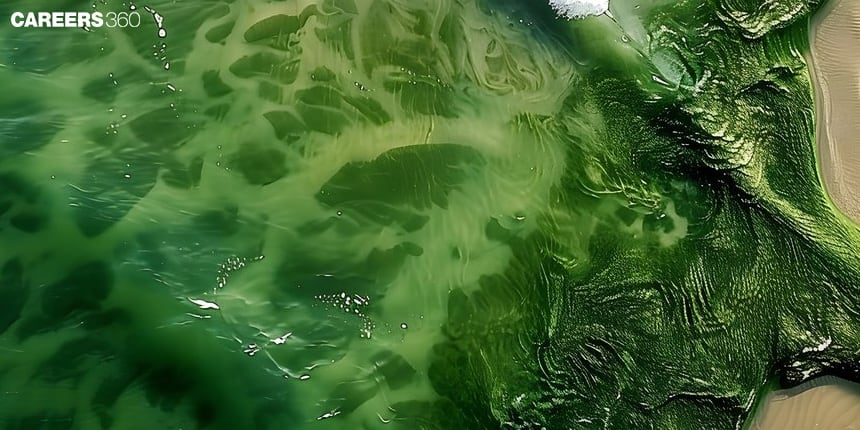Algal Bloom: Definition, Meaning Causes, Importance, Types
An algal bloom is a rapid increase in the population of algae in a water body, often resulting in a dense layer of algae on the surface. This phenomenon is typically triggered by factors such as excess nutrients, especially nitrogen and phosphorus, which promote the rapid growth of algae. The algal bloom definition refers to this sudden proliferation of algae that can deplete oxygen in the water, disrupt aquatic ecosystems, and affect water quality. An algal bloom is an important topic in Class 11 biology which is linked to some of the major weightage units from an examination point of view.
NEET 2025: Mock Test Series | Syllabus | High Scoring Topics | PYQs
NEET Important PYQ's Subject wise: Physics | Chemistry | Biology
New: Meet Careers360 B.Tech/NEET Experts in your City | Book your Seat now
- What is an Algae Bloom?
- Importance of Algae
- Types of Algal Blooms
- Cause of Algal Bloom
- Recommended Video for Algal Bloom

What is an Algae Bloom?
An algal bloom is a sudden increase in the population of algae in an aquatic system, often resulting in visible changes, such as water discolouration. This phenomenon can occur in both freshwater and saline environments and is influenced by physical, chemical, and biological factors. To define algal bloom, you need to understand the rapid growth of algae that can alter the characteristics of the water.
An algal bloom is further classified into harmful and non-harmful blooms. Harmful algal blooms produce toxins that can negatively impact aquatic life, humans, and animals. On the other hand, non-harmful blooms, although non-toxic, can still cause environmental issues, such as hypoxia— a condition where oxygen levels in the water become dangerously low.
While algal blooms are not a new occurrence, their intensity and frequency have increased recently due to human activities like agricultural runoff, wastewater discharge, and climate change. As part of the study of algal bloom in Class 11, it is essential to understand these causes and effects in order to develop strategies for prevention and control.
Also Read:
Importance of Algae
Algae play a crucial role in ecosystems, and understanding algal blooms is essential for their management. Algal bloom research contributes significantly to our knowledge of their impact on the environment, economy, and human health.
From an ecological perspective, algal blooms can disrupt oxygen levels in aquatic ecosystems, leading to fish kills and the mortality of other aquatic life. Algal bloom definition includes both harmful and non-harmful blooms, with harmful blooms often causing severe ecological imbalances.
Economically, algal blooms can damage fisheries, tourism, and water treatment processes, resulting in significant financial losses. Moreover, certain phytoplankton blooms produce toxins that can contaminate drinking water sources, posing a threat to both human and animal health, leading to illnesses or even death.
Types of Algal Blooms
The various types of algal blooms are defined as:
Harmful Algal Blooms (HABs)
The harmful algal blooms result from algae producing toxins poisonous to aquatic life, humans, and animals. Common types of harmful algae include cyanobacteria also known as blue-green algae, dinoflagellates, and diatoms. They result in fish kills, shellfish poisoning, and other health problems.
Non-Harmful Algal Blooms
They do not produce toxins, but nontoxic algal blooms still have major ecological implications. For example, they can produce hypoxia, which creates dead zones where no aquatic life can live. It can block sunlight from going down to underwater plants and throw off the aquatic food chain.
Cause of Algal Bloom
Algal blooms are caused by these reasons:
Nutrient Pollution (Nitrogen And Phosphorus)
The excess nutrients, mostly nitrogen and phosphorus, are key reasons behind algal blooms. Normally, these nutrients get into the water body from agricultural runoff, discharging of wastewater, or other industrial processes. High nutrient levels increase the growth rate of algae, promoting blooms.
Light Availability
Light is yet another essential element required in algal blooms. It is linked to photosynthesis, and high light availability in clear shallow waters favours high populations of algae. Seasonal variability can, however, still affect light penetration onto shallow areas, as can water turbidity.
Water Temperature
The water temperature displays a bias towards warmer conditions, with most blooms occurring in summer. Climate change is, therefore, raising the water temperature, likely to lead to significantly more frequent and serious algal blooms.
Water Movement and Stability
Stable water conditions characteristic of stagnant or slow-flowing waters tend to favour algal blooms. On the contrary, the turbulent nature of waters can disperse algae and limit bloom formation. Human activities, in particular on rivers by way of damming and flow alteration, create the perfect conditions for blooms.
Recommended Video for Algal Bloom
Also Read
Frequently Asked Questions (FAQs)
Excess nutrients, particularly nitrogen and phosphorus, combined with ample sunlight, warm water temperatures, and stable water conditions can spur an algal bloom.
Harmful algal blooms can produce toxins affecting human and animal health, contaminate drinking water, and disrupt aquatic ecosystems.
Prevention includes the reduction of nutrient pollution from agricultural runoff, wastewater discharge, and industry, coupled with water quality management.
Algal blooms can cause damage to fisheries, reduce tourism, and increase the costs of water treatment, thereby causing high economic losses.
The toxins produced during harmful algal blooms can result in tightness of the chest and respiratory anomalies, skin irritations, gastrointestinal diseases, and sometimes even death in humans and animals.
Also Read
25 Nov'24 10:17 AM
14 Nov'24 11:00 PM
14 Nov'24 03:31 PM
14 Nov'24 01:18 PM
14 Nov'24 11:37 AM
14 Nov'24 08:30 AM
22 Oct'24 03:31 PM
10 Oct'24 06:09 PM